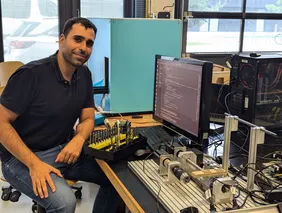Solution to a well-known problem in measurement technology: some objects are very difficult or impossible to image using conventional methods, especially if they are reflective, and have complex shapes or fine scattering structures.
The invention by Mühenad Bilal and Christian Mayer provides a remedy. They have utilised various physical theories. ‘The behaviour of light-matter interaction is complex. One of the tasks of physicists is to observe this behaviour and formulate laws from it to use them for various applications,’ explains Mühenad Bilal, physicist and doctoral student at THI's Artificial Intelligence Doctoral Centre.
He and Mayer have been working on their invention for over three years - at the university and their kitchen table at home. With the help of the physical laws of light-matter interaction, sophisticated ray tracing techniques, and a deep understanding of artificial intelligence, the two researchers have developed an approach that precisely captures even the most complicated and optically demanding test specimens, making the AI's work easier.
The close collaboration between the university and Linner GmbH has made this innovative product possible and provides the basis for further developing the approach in future projects and opening up new fields of application. Linner GmbH provided the university with the problem definition and supported it with valuable know-how and expertise. Managing Director Ludwig Linner and THI professors Markus Bregulla and Daniel Großmann were involved in the development process. The ‘Information and Communication Technologies’ (IUK) and ‘Central Innovation Programme for SMEs (ZIM) programs funded the project.


![[Translate to English:] Logo Akkreditierungsrat: Systemakkreditiert](/fileadmin/_processed_/2/8/csm_AR-Siegel_Systemakkreditierung_bc4ea3377d.webp)








![[Translate to English:] Logo IHK Ausbildungsbetrieb 2023](/fileadmin/_processed_/6/0/csm_IHK_Ausbildungsbetrieb_digital_2023_6850f47537.webp)


